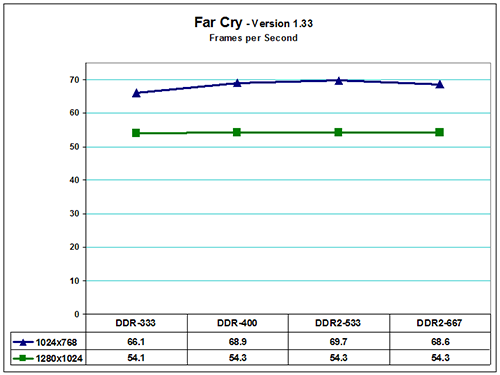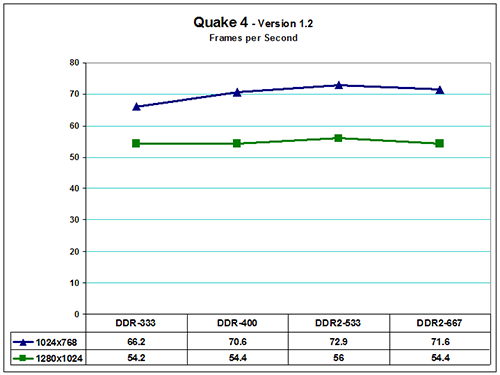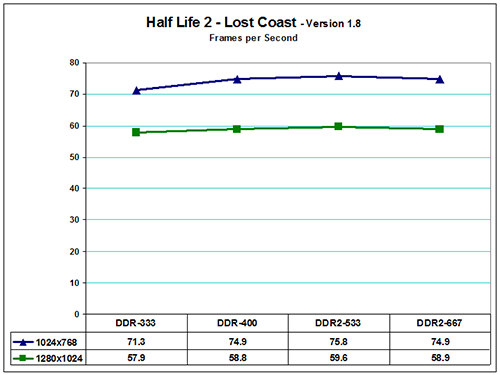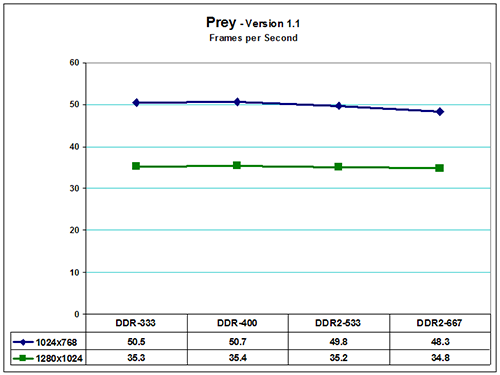ASRock 775Dual-VSTA: Does DDR2 matter?
by Gary Key on August 8, 2006 6:35 AM EST- Posted in
- Motherboards
Game Performance Comparison
While Sandra and Super Pi provide useful information on how memory performs without the influence of other components, our first round of real world tests has shown there is not a large difference in performance between DDR2 and DDR memory on this particular platform. However, our next set of real-world benchmarks consists of gaming benchmarks.
We utilize Far Cry, Half-Life 2 and Quake 4 in our normal memory testing because they are sensitive to memory changes. We are adding Prey and Serious Sam II to our benchmark mix because they are typically very GPU dependent and we will see the effects of our memory choices on these games. We tested at both 1024x768 and 1280x1024 at High Quality settings but without anti-aliasing or antistrophic filtering enabled. We feel like these settings are representative of a platform at this price point and believe most users would be utilizing a 17" or 19" monitor with this setup.





Our three memory sensitive games show a slight difference in results at 1024x768 but are GPU limited at 1280x1024 for all intents and purposes. The performance pattern is similar to the synthetic benchmarks with the DDR2-533 setting performing best overall. The DDR2-667 and DDR-400 configurations basically end in a tie with the DDR-333 finishing last. Our two GPU limited games actually favor the DDR-400 memory setup although the scores across the board are well within our margin of test error.
Overall, gaming performance is fine with low latency DDR-400 memory on this platform. Even DDR-333 provides for acceptable performance, particularly if you're looking to upgrade from an old socket A or 478 system. In that case, you might also want a new GPU, but we'll take a look at PCIe vs. AGP performance in part two of this series.
While Sandra and Super Pi provide useful information on how memory performs without the influence of other components, our first round of real world tests has shown there is not a large difference in performance between DDR2 and DDR memory on this particular platform. However, our next set of real-world benchmarks consists of gaming benchmarks.
We utilize Far Cry, Half-Life 2 and Quake 4 in our normal memory testing because they are sensitive to memory changes. We are adding Prey and Serious Sam II to our benchmark mix because they are typically very GPU dependent and we will see the effects of our memory choices on these games. We tested at both 1024x768 and 1280x1024 at High Quality settings but without anti-aliasing or antistrophic filtering enabled. We feel like these settings are representative of a platform at this price point and believe most users would be utilizing a 17" or 19" monitor with this setup.





Our three memory sensitive games show a slight difference in results at 1024x768 but are GPU limited at 1280x1024 for all intents and purposes. The performance pattern is similar to the synthetic benchmarks with the DDR2-533 setting performing best overall. The DDR2-667 and DDR-400 configurations basically end in a tie with the DDR-333 finishing last. Our two GPU limited games actually favor the DDR-400 memory setup although the scores across the board are well within our margin of test error.
Overall, gaming performance is fine with low latency DDR-400 memory on this platform. Even DDR-333 provides for acceptable performance, particularly if you're looking to upgrade from an old socket A or 478 system. In that case, you might also want a new GPU, but we'll take a look at PCIe vs. AGP performance in part two of this series.










55 Comments
View All Comments
Calin - Wednesday, August 9, 2006 - link
Yep, I feel stoopid :)Anyway, the idea is that a change in memory patterns (SDR to DDR, SDR to RDRAM, DDR to DDR2) is a battle between old very optimised technology, and new, unproven yet technology. The small difference in speed can be explained that "current" technology in processors is built for best performance with current memory - a new memory type often is not optimised for the memory access needed by the processor.
As an example, RDRAM was (just a tad) slower on Pentium !!! (compared to high performance SDRAM). Pentium4, which was bandwidth starved with single channel SDRAM, was much faster with RDRAM (dual channel though) - as much as a P4 2000 (Willamette) with SDRAM was equal to a P4 1600 with RDRAM. As speed increased, needed bandwidth increased too - but the move to dual channel DDR was the final nail in the coffin of RDRAM on PC.
The other example - Athlon64 is not bandwidth starved on current (dual channel DDR400) memory, so doubling memory bandwidth brought no advantage. The decrease in latency was not enough to bring extra performance.
The situation is mostly similar with Core2Duo - more memory bandwidth brings little advantage.
This might change for quad-core processors, as they could use twice the memory bandwidth we see now - or on the Athlon side with a more aggressive prefetching algorithm (which will eat bandwidth bringing data that seem to be useful in the near future).
yacoub - Tuesday, August 8, 2006 - link
"When faced with a limited budget but a desire to have the latest and greatest technology, it is usually has to cut corners"should be "one usually has to cut corners"
yacoub - Tuesday, August 8, 2006 - link
page 2:"...one of the widely used setups in use today." Maybe you like the extra words but you could drop the words "in use" and still be making the same point.
"The memory features average latencies at DDR2-667 but was able to perform at lower latencies in our testing while costing around $70 for a 1GB kit.
{transcend-ddr2.html}" <--- supposed to be a link or image?
JarredWalton - Tuesday, August 8, 2006 - link
Blame the sleepy editor. :|The Transcend table was present, but the supported RAM speeds table was not. I fixed the error, as well as the other two grammar issues you pointed out. Thanks!
yacoub - Tuesday, August 8, 2006 - link
hehe no problem. =)